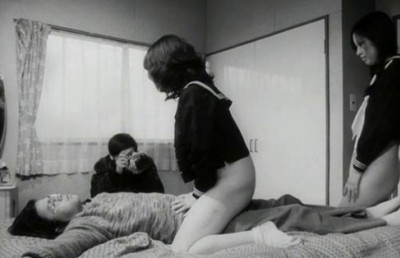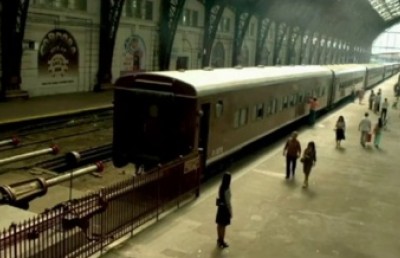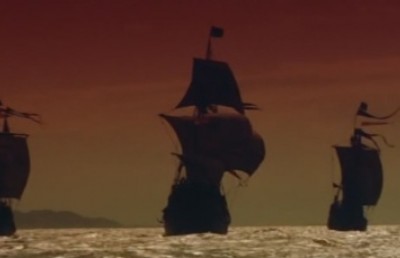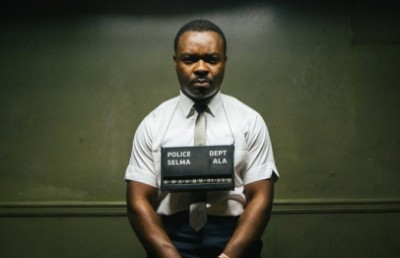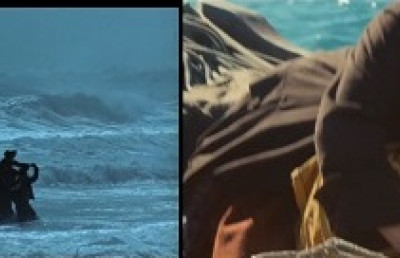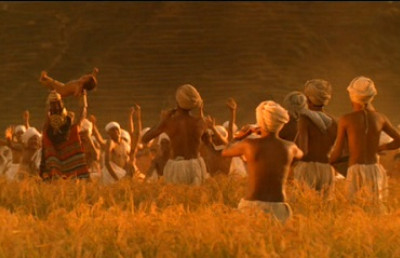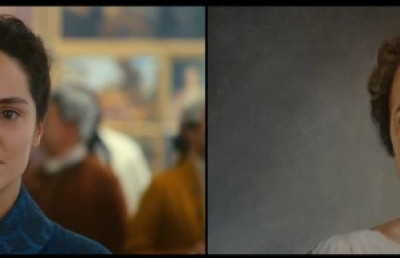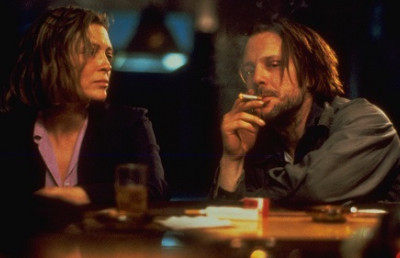The Cosmopolitan Perspective, the Rebellious Impulse: The Matrix trilogy and Snowpiercer ( Part 1)
How are we to make freedom real?
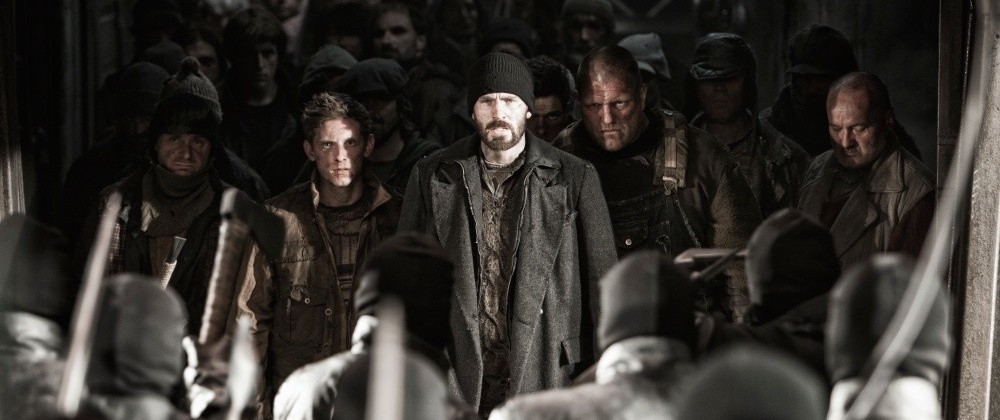
“You laugh to yourself at the ability of our first mistakes / to be carved in stone. You ask: When will I be cured of defining the whole / by the part? The feather is not the bird, the tree is not the forest, and the / threshold is not the house.”
—Mahmoud Darwish, In the Presence of Absence (Archipelago, 2011; page 25)
It can be fascinating to see something you think you know—something you think you like—and then to realize that there are aspects of it that you have not thought of enough or at all: and that occurred when I saw The Matrix trilogy within days of seeing a more recent film, Snowpiercer (2013), a film that takes place in a future world in which humanity, divided by class, resides on a moving train. (Snowpiercer screened abroad in the 2013, where it was successful, but opened to smaller audiences in 2014 in the United States.) I had thought of The Matrix, a futurist film in which computers rule, as being about a successful revolution, but, actually, the Wachowski film trilogy—_The Matrix_ (1999) and The Matrix Reloaded (2003) and The Matrix Revolution (2003), all directed by the Wachowski siblings—is about a heroic rebellion that ends in the mutual co-existence of men and machines with the smallest of changes, that, principally, being that those who want to leave the system are allowed to leave, rather than the destruction of the system. Both Snowpiercer and The Matrix are about power, rebellion, and the recuperation of power: the system actually assumes, prepares for, tolerates, and recuperates from rebellion, forms of resistance and reactive response (as a way of evading revolution, fundamental change). The governing system recognizes that human nature fixates on misery—generates it, and thinks about, imagines and pursues remedies—so unhappiness and how to manage it have to be assumed, with a method for amelioration and recuperation. Recuperation is a return to a former state; a healing of a breach; an attainment of endangered priorities and projects through strategy and subterfuge, such as annexation, commodification, incorporation, or neutralization; a recovery of materials, power, and wealth; return, reversal, retrenchment. It is the system that recuperates. In Snowpiercer, directed by Bong Joon-ho, rebellions are accepted for population control—an opportunity to kill excess numbers of people, preventing exhaustion of material resources. In The Matrix, a messiah figure is a focus of energy and belief, a way to channel impulse, another mechanism of control, and, finally, the messiah fights for his people but must return to the system, must become part of it, to provide them adequate defense and protection. What, after all, has been the benefit of human effort, of resistance?
The people go in circles in Snowpiercer, the 2013 film inspired by a 1982 French graphic novel by Jacques Lob and Jean-Marc Rochette and directed by Bong Joon-ho: following the attempt of the world’s nations to execute a strategy to fight global warming, the entire planet goes cold, with snow and ice everywhere, and what survives is a brilliantly designed, beautifully equipped train that travels, without stopping, all over the world. While the upper classes get the food, culture, and service they are accustomed to, the poor get protein bars and a filthy environment—and sometimes the poor children are taken from their parents for duties the parents do not know or understand. The monotony of life as well as the cruelty of impoverished existence leads to the rebellion of Curtis (Chris Evans), a young man guided by an older one, Gilliam (John Hurt), who has some kind of rapport with the train’s managers (the extent of which is not known to Gilliam’s fellow travelers); a rebellion aided by an imprisoned train engineer, Namgoong Minsu (Song Kang-ho), and the mother of an abducted boy, Tanya (Octavia Spencer), among others. The rebellion begins during mealtime and goes from car to car, and the rebels must fight armed guards, but the rebels capture a middle manager, Mason (Tilda Swinton), who helps them move up to the train’s engine. When the rebel leader Curtis finally meets the train’s designer and owner, Wilford (Ed Harris), Curtis learns of the treacheries that have occurred to maintain order—including collusion where Curtis did not expect it: the rebellion had been approved by Wilford before it began, as a method of population control. It is impossible to describe the full sense of despair and disappointment that follows—or the anger.
What can one do but go in circles, or dream, or rebel? The future is one in which most of the people are asleep, dreaming of life, and used for their body energies in a world run by and for computers in The Matrix film trilogy, a project of imagination, ideas, spirit, and style. Human beings had created great computers for use—utility being a justification for much in human society—and, after conflict and war, the human beings were being used by the artificial intelligence of computers (some philosophers have argued that an improbability, as computers are programmed and lack independent consciousness and motivation; but the validity of the scenario may rest less with motivation than momentum: created systems develop momentum, influencing us: a system’s effect is that people rely on it and no longer think or judge for themselves). Yet, in The Matrix a computer programmer with rebellious instincts, Thomas Anderson/Neo (Keanu Reeves), is seen as a great hope for those who have awakened, such as Morpheus (Laurence Fishburne) and Trinity (Carrie-Anne Moss), who free Anderson/Neo from the computer network and induct him into their organized rebellion. Morpheus is a leader and warrior with the humility to accept that another man, not himself, is meant to be savior; and Trinity, a computer wizard, trusts Morpheus’s judgment, and through observation sees Neo’s valor. Neo (Reeves) is taught a wide range of skills, physical and mental, making him into a formidable warrior. Neo learns to deconstruct the apparent realities, understanding how much of his own belief is necessary for anything to be real. How much is Neo willing to give for freedom for himself, and his new associates? Will Neo put himself at risk? When Neo works to free a captured Morpheus (Fishburne), Neo shows how much he has learned and improvises new abilities as Neo fights against the agile, suited computer agents. Neo (Reeves) fulfills his destiny not by deciding who he is, but by caring and by acting on his beliefs. Subsequently, in Matrix Reloaded, Morpheus’s crew joins with others to fight destroyer sentinels headed toward Zion, the city where rebels live. One of the agents has gone rogue (the fastidious Agent Smith, played by Hugo Weaving). Neo’s interactions with the Oracle (Gloria Foster) and the Architect (Helmut Bakaitis) give Neo two views of the possibilities for the computer system known as The Matrix: the friendly, lightly mocking Oracle (Foster) embodies instinct, possibility, and liberty, and the austere, lordly Architect (Bakaitis) embodies order, planning, and control. As part of his adventures Neo encounters figures with supernatural resonances—that of angels, vampires, and ghosts, other rogue programs. It is the Architect who explains much of The Matrix and its working to Neo, including that Neo is part of The Matrix’s plan—that Neo is not the first messiah, but, depending on the choice Neo makes, Neo could be the last: will Neo choose to let the whole system crash, or choose to repopulate Zion once it has been destroyed? Neo’s exertions—and the intervention of an enemy—leave Neo in limbo, where he is at the beginning of Matrix Revolutions, but Neo (Reeves) is rescued by his friends and comrades Morpheus (Fishburne) and Trinity (Moss), figures of faith and strength and dash. The invasion of Zion by the sentinels occurs, while Neo is traveling to the Machine City to encounter the computers—to attempt to plug into the system again, wanting those network resources to fight Agent Smith, who seems determined to destroy both man and machine: Smith has become a colonizer, a virus. Consequently, once Neo becomes attached to the network and its resources again, Zion is spared; and the people who want to be free of the exploitive system (not everyone)—free of The Matrix —will be allowed to leave. It has been a rebellion, not a revolution.
Why does art give us visions of the limits of human actions? Art allows us to see what is real and what is possible and what is improbable. Art is revelation: it is experience transformed into consciousness, and consciousness given form, created by one artist or more, and shared with other people, becoming part of a larger conversation. What is the value of art and of intellectual life? What is freedom? What is the ideal relation of the individual to the community? What are the pleasures and insights and resources of a cosmopolitan perspective, life, and society? What hope, if any, is there for people—for a community—that does not recognize or reward individuality, intellect, and imagination? The ability, desire, and opportunity to choose the kind of life, work, and relationships one will have are the fundamental liberties that most aware and intelligent people want. To be oneself with confidence and joy, to pursue the nature and development of one’s own mind and spirit, with the promise of growth and possibility—without censure, doubt, misery, or punishment, are ideals; and yet to be oneself surrounded by respectful and inspiring colleagues and loving and loyal friends, by a genuine community, sharing art and culture, philosophy and principle, pleasures and purposes, is an even greater ideal. Where can the ideal of self and community be lived, in town or country, a large city or a small town? I think the ideals of creativity, liberty, self, and community can be lived best in a large city, but—to each his own. The city offers the possibility and practice of diversity, of invention, of plenitude. Often the resources and routines of country life and small towns are too limited, too given to repetition and repression of choice and difference. Yet, it is easy to forget some of the basic things that make a civilization or even a life while living in a city: the provision of the bare necessities and the management of materials and money. What are the skills and knowledge one needs to survive and prosper? Who grows the food? Who makes the tools, the utensils, and the furnishings? Who teaches the children? Who gives care to the sick? In small town or country living, it is hard, maybe impossible, not to know how the basics come to be, and are sustained. Often one finds—when one is completely honest, radical—that one requires the thing one loves—art or philosophy—and what also appears to be its opposite: the benefits of thoughtless toil, a toil that needs as much care and consideration as a poem or sonata. How, then, are we to be true to the complexities of individual life and communal life, of city and country, of nation and world? The cosmopolitan perspective is one that might be able to hold in mind all the complexities and contradictions: the cosmopolitan looks—and travels—in mind, if not in body, beyond the limited and the local, seeking knowledge, liberty, and pleasures that fulfill the broadest, deepest, most genuine possibilities.
What is freedom? What is the ideal relation of the individual to the community? The command of mind, will, and resources is power; and in society power contends with power. The struggle over purposes and principles, energies and forces, goods and services, is the realm of power, of the political—politics. Often when we say we dislike politics, we mean that we dislike other people’s responses to the political, their limited or rigid thought and practices. Often much of our own thinking about the political remains in silence. It is remarkable—and inevitable—that many of the stories that are told in arts and culture are about politics. Further, some of the most popular stories are repudiations of repression, tales of rebellion: and that is true of recent films such as Belle, Dear White People, Kill the Messenger, Leviathan, The Loving Story, The Normal Heart, Omar, and Selma. Ava DuVernay’s Selma (2014), like Belle and Kill the Messenger and The Loving Story, is a work in which the political is more than a fancy or a fantasy; it is fact: Selma is a portrait of an African-American voting rights campaign inspired by moral imagination and shaped by pacifist protest, a campaign led by Martin Luther King Jr. that asked Americans to judge political practice by political principle and drew the increasing attention—both hostility and sympathy—of Americans. The campaign was a rebuke to a history of enslavement, economic exploitation, social segregation, and ongoing negative discrimination; a history born of, and buttressed by, an ignorance of others, moral vanity and puritanism, an encounter with wilderness that makes civilization an ideal and the necessity of identifying an other to civilization inevitable, fearful survival and greed, a desire for cheap labor and resources, selfishness, intolerance, disregard for the flesh, repressed lust and eruptions of lust, denial of human responsibility, a guilty conscience and fear of both retribution and demand for reparations. The voting rights campaign, a project of the African-American civil rights movement, was an affirmation of humanity, of dignity and intelligence, of moral authority and political progress.
Films such as Belle and Leviathan and Omar and Selma are now part of a panoply of photoplay projects taking on political subjects through the decades: Advise and Consent, All the President’s Men, The Battle of Algiers, Battleship Potemkin, Before Night Falls, Black Legion, Bob Roberts, Born in Flames, Born on the Fourth of July, Bulworth, Burn!, Burnt by the Sun, The Candidate, Casino Jack, Casualties of War, Charlie Wilson’s War, Coming Home, The Conformist, Cry Freedom, A Day without a Mexican, Dr. Strangelove, A Dry White Season, Edge of the City, Election, A Face in the Crowd, Fail Safe, Fires on the Plain, Gandhi, Get on the Bus, The Glass Shield, Glory, The Great Dictator, The Great McGinty, Hollywood Shuffle, Inherit the Wind, Intolerance, Lincoln, Lions for Lambs, Little Big Man, The Lives of Others, The Long Walk Home, The Manchurian Candidate, Matewan, The Mattei Affair, Meeting Venus, Monsieur Klein, The Mortal Storm, Mr. Smith Goes to Washington, Napoleon, Nashville, Night Catches Us, Nightjohn, Norma Rae, Paradise Now, The Parallax View, Primary Colors, A Raisin in the Sun, Red State, Reds, Rosa Luxemburg, Sammy and Rosie Get Laid, Sankofa, Syriana, The Talk of the Town, Thank You for Smoking, The Third Man, To Kill a Mockingbird, Under Fire, Wag the Dog, The Wind that Shakes the Barley, and The Yacoubian Building. D.W. Griffith’s long multi-narrative Intolerance (1916) moves through history and conflicts of religion and wealth, as it critiques moralists and social reformers; Sergei Eisenstein’s five-act silent film Battleship Potemkin (1925) focuses on a Russian shipboard mutiny; Stanley Kramer’s fictional Inherit the Wind (1960) harkens back to an actual legal case involving education and the teaching of evolution versus divine creation (the 1925 Tennessee case involving teacher John Scopes and William Jennings Bryant and Clarence Darrow); Gillo Pontecorvo’s Battle of Algiers (1966) shows the war of Algeria for independence against France, featuring a battle in the country’s largest city Algiers, and is considered as instructive as a training manual; and in Stephen Frears’ multicultural, even postmodern Sammy and Rosie Get Laid (1987) history catches up with an Asian political leader who escapes to London to be with his bohemian son and daughter-in-law; and in Warren Beatty’s comic Bulworth (1998) a United States senator goes through a crisis and begins to tell the truth of how politicians are bought. There are political comedies and tragedies, some of history and others of imagination—and a film for every temperament. It is strange that we speak often as if political films are rare. Is it only that it is difficult to sustain conversation around them? That may be one form of power’s recuperation—a return to more mundane topics. Of course, much of popular culture is not about accruing meaning but evading meaning—and the absence of meaning is received as liberating, as the possibility for fun. In Snowpiercer and in The Matrix trilogy, cinematic works that give pleasure and provoke thought, are allegories of repression, rebellion, and the recuperation of power.
In Snowpiercer, the divisions among the classes are stark, with the poor filthy and hungry, their fates determined by others, but in The Matrix, where many people seem enveloped in a more pleasant reality, there is a sense of inauthenticity, a lack of conviction and purpose—and it turns out the people are not truly living for themselves, and their lives are mere simulations. It is hard to imagine stories more extreme, more pessimistic about the future, more encouraging of rebellious impulses, and more small and futile in ultimate consequences and conclusions. Snowpiercer, full of color and speed, and thoughtful, well-acted, is a parable of class struggle, of power and survival under pressure: at the end of civilization, a grand train of luxury and evolved technology is a surviving ark, with moneyed people in the front of the train and the poor in the back. In Snowpiercer, rebellion is cultivated, achieves momentum, and incurs losses, but proves to be much less than it first seemed: rebellion turns out to be part of the negative and necessary assumption of established power. Something similar occurs in The Matrix, a three-film meditation on reality, computers, love, fear, control, inevitability, and revolution. The predictability of human nature is used against a suffering populace yearning for freedom in both stories. Is it discouraging or liberating to face such facts, such stories? The disenfranchised tend to see their realities in the most basic terms—survival and lack, principally lack of power and wealth—though there is often lack of knowledge and skill too. The aspects of life—the intellectual, the artistic, the spiritual—that could be empowering are neglected, marginalized: the realties that might offer an alternative standard of value—other possibilities—are disrespected.
The French philosopher and writer Albert Camus argued that rebellion is instinctive, but revolution intellectual, structural; and, Camus asserted, revolution ends not only in a change of government but in stronger government. In Camus’s meditation on rebellions philosophical, literary, and political, in the book The Rebel, an eloquent, insightful, and timeless work, Camus wrote, “Absolute revolution, in fact, supposes the absolute malleability of human nature and its possible reduction to the condition of a historical force. But rebellion, in man, is the refusal to be treated as an object and to be reduced to simple historical terms. It is the affirmation of a nature common to all men, which eludes the world of power” (Vintage/Knopf, 1956; page 250). The rebel, out of anger and pride, reacts to circumstances that offend and wound; and the revolutionary, out of analysis, passion, and a desire for power, insists that others react to his/her demands and ideas. The rebel desires unity of being, an acceptance of differences, and respect for his basic humanity—equality; however, the revolutionary insists on the totality of perspective and purpose, on sameness, and dominance. The rebel smashes objects of value out of rage, while the revolutionary smashes people of value, justifying murder with reasons. It is possible for a rebel to be disciplined, and for a revolutionary to be moral—but those are rare. What are the prospects for significant political action today? The book Age of Acquiescence: The Life and Death of American Resistance to Organized Wealth and Power (2015) by historian Steve Fraser is an examination of the decrease in mobilization against immoral power and wealth, after a long history of movements against slavery and servitude and for workers’ rights and better pay: Fraser finds that people now have trouble imagining alternatives to exploitive capitalism. Yet Chris Hedges suggests that this period—when many people know debt and insecurity and poverty—may be a time of rebellion and revolution in Wages of Rebellion (2015), a book in which Hedges, like Steve Fraser, recounts past difficulties and activist responses; and Hedges attempts a rallying cry. Will it be heard? The human being can be attentive or blind and deaf, beautiful or ugly, moral, amoral, or immoral. One resists one’s own ignorance, fear, hatred, inertia, lethargy, stupidity, and weakness and that of others: one thinks and acts. One enters the realm of the political—aware, intent, struggling—to advance and protect certain principles and projects, and not, usually, for power for its own sake: most people prefer to think about family and friends, other priorities, other pleasures. One is distracted by pettiness and by power and can be defeated by short-term tactics rather than long-term strategy.
The choices and consequences of human thought, action, and struggles become history; history is record and interpretation; history is represented in memories and customs, institutions, and laws. Human history is full of inventions, revelations, and wonders, as well as catastrophes and crises; and yet the quotidian—the ordinary—is what we consider definitive. We arrive at each morning as if the significant past does not exist, as if an astounding future is not to be. We take for granted the airplane and the computer and much else. Where did it all begin and where is it going? “The 1600s produced the most remarkable and diverse technes upon which we ground modernity: Dutch microscopy, Italian telescopy, Continental optometrics, Newtonian physics, and the English forays into cardiac research. To those mechanical and clinical achievements of the age, I would add the Spanish novel and the Italian opera,” states scholar William Germano in “Of Credos and Credibility,” a contribution to The Critical Pulse, a collection of diverse critical statements that remind the reader that literary creation and appreciation take place in—and transform, and are transformed by—the confines of history (Columbia University Press, 2012; page 144). History is a narrative of origins and possibilities, shaping society and sensibilities; and, while it is perceived, read, as a firm and forceful text, new chapters are being added with each year. Modernity is the culmination of culture, knowledge, and technology, the advance stage of a civilization in which its possibilities extend from a few people of exceptional gifts and wealth to the many. Its effects can be felt everywhere, by those who can discern what those effects mean and by those who cannot. There is a tension between history and instinct, and between history and intellect—and the possibility of nihilism or transcendence. History is a series of changes. The impoverished imagination is bewildered by modernity, lacks significant experience and insight, and is incapable of thoughtful adaptation or profound joys; and the values of an impoverished imagination are narrow, small, mean, selfish; and it knows fear and intimidation as close companions—the impoverished imagination fears contamination and death, not recognizing that it has been contaminated already, and is half-dead too. The impoverished imagination cannot comprehend modernity nor what comes after; and yet the confusions of postmodernism suits the impoverished imagination by not demanding or providing strict order. Postmodernism, the age that follows modernity, is an era of change and doubt, of multiplicity of culture and perspective, of industry and internationalization, of commerce and critique, of contradiction, fragmentation, and entropy: postmodernism is a time of loss and of plenty; and a chance for reconstructions. The cosmopolitan perspective knows what is of value in civilization, what lasts, what is to be savored and protected in times of change and trouble. The cosmopolitan mind sees the city and the neighborhoods, individual blocks, and solitary homes; the forest and the trees, plants, and flowers; the general and the particular, and the general in the particular. The cosmopolitan individual has respect for history, philosophy, science, and art; knows and is capable of evaluating art, whether folk, popular, high art, or avant-garde art; and appreciates local, national, and international cultures.
The cosmopolitan person appreciates a multiplicity of people, places, and things: abstraction, Abuja, Thomas Ades, Chimamanda Adichie, David Adjaye, James Agee, Michelle Alexander, Sherman Alexie, algorithms, Robert Altman, ambiguity, Brett Amory, Tori Amos, Wes Anderson, Michelangelo Antonioni, Armani suits, Ashera cats, Bach, Francis Bacon, ballet, Andre Bazin, Romare Bearden, Ingmar Bergman, bicycles, Andrew Bird, Black Lives Matter, bluegrass music, first edition books, Brasilia, the British Broadcasting Corporation, Jeff Buckley, Buddhism, Burberry coats, Cairo, purple carrots, Jimmy Carter, Stanley Cavell, Cezanne, Chanel suits, Charlie Chaplin, charity, Anton Chekhov, Patrice Chereau, chess, chocolate, Montgomery Clift, coffee, comic books, Common, complexity, Confucius, Paolo Conte, Tim Cook, Misty Copeland, Corgi puppies, criticality, Alfonso Cuaron, cunnilingus, Tony Curanaj, curiosity, Dakar, Salvador Dali, Aliko Dangote, Julie Dash, Richard Dawkins, De La Soul, Samuel Delany, delight, Catherine Deneuve, Claire Denis, Rene Descartes, diamonds, discovery, Carl Dreyer, Ava DuVernay, Thomas Eakins, Atom Egoyan, Chiwetel Ejiofor, elegies, Elizabeth I, Duke Ellington, Megan Ellison, eloquence, Okwui Enwezor, Louise Erdrich, Cesaria Evora, Faberge eggs, fellatio, fish oil, E.M. Forster, Lucian Freud, friendship, fruits, Meta Fuller, Jules Furthman, Gandhi, Greta Garbo, Shadi Ghadirian, Nicolas Ghesquiere, Fabiola Gianotti, Rhiannon Giddens, Massimiliano Gioni, Philip Glass, Jean-Luc Godard, Google, Lewis Ricardo Gordon, Saed Haddad, Conrad Hall, ham, P.J. Harvey, Ihab Hassan, Palmer Hayden, Ben Hecht, Helsinki, hiking, Agnieszka Holland, James Wong Howe, humor, ice cream, interpretation, irony, Istanbul, Vijay Iyer, Henry James, jazz, James Jean, Thomas Jefferson, Branden Jacobs-Jenkins, Pauline Kael, Kafka, Janusz Kaminski, Grace Kelly, Khaled, Abbas Kiarstami, John Koethe, Akira Kurosawa, Liane La Havas, Christine Lagarde, Kendrick Lamar, Jacob Lawrence, Ang Lee, Leonardo of Vinci, Tony Leung Chiu Wai, Edmonia Lewis, Samella Lewis, Matthew Libatique, Phillip Lim, Abraham Lincoln, literary discussions, Blake Lively, Mario Vargas Llosa, John Locke, London, Emmanuel Lubezki, Ernest Lubitsch, Macklemore, Guy Maddin, Terrence Malick, maqam, marijuana, Kerry James Marshall, Mercedes-Benz, Angela Merkel, Steve McQueen, Michelangelo, Ezra Miller, Montaigne, moon landings, Jason Moran, Toni Morrison, Mozart, Nico Muhly, luminescent mushrooms, National Public Radio, New Orleans, Ngũgĩ wa Thiong’o, Stavros Niarchos III, Martha Nussbaum, Barack Obama, Occupy Wall Street, the Olympics, opera, Orhan Pamuk, Oslo, pastry and pies, patience, white peacocks, Carl Phillips, physics, Picasso, Adrian Piper, Pope Francis, Zac Posen, Sally Potter, the Public Broadcasting System, Qawwali, Queen Latifah, John Rawls, Satyajit Ray, Robert Redford, Steve Reich, Rembrandt, Jean Renoir, Oscar de la Renta, Shonda Rhimes, Robert Richardson, John Ridley, Rihanna, Josh Ritter, Eric Rohmer, Rome, Saoirse Ronan, Franklin Roosevelt, Zoe Saldana, Walter Salles, San Francisco, Oumou Sangare, John Singer Sargent, Augusta Savage, Fred Schepisi, Julian Schnabel, Ousmane Sembene, Amartya Sen, Shakespeare, Leslie Marmon Silko, Abderrahmane Sissako, Patti Smith, soccer, Stephen Sondheim, Susan Sontag, Sorraia horses, Luciana Souza, space probes, Elia Suleiman, Andre Leon Talley, tango, Tasmanian giant crabs, tea, Andre Techine, tennis, Tiffany lamps, Alma Woodsey Thomas, Bob Thompson, Tokyo, Gregg Toland, Marisa Tomei, A Tribe Called Quest, David Dante Troutt, Francois Truffaut, trust funds, Tina Turner, Mark Twain, Neil deGrasse Tyson, Ike Ude, the United Nations, Univision, Vampire Weekend, vanilla, Agnes Varda, Gore Vidal, Luchino Visconti, vitamins, Gerald Vizenor, Voltaire, Andy Warhol, Reggie Watts, Florence Welch and the Machine, Oscar Wilde, wine, wit, Wong Kar Wai, Dustin Yellin, Fred Zinnemann, and zydeco.
Yes, yes, and yes; the cosmopolitan mind gives much attention to beauty: beauty is a person, place, or thing of perfect and pleasing form and qualities; an eloquent, excellent, and exquisite balance of color, shape, and size; of distinct and appropriate place; of sound—rhythm, tone, pitch, texture, and volume; of apt duration; logical and ordered; of interesting depth and attractive surface in suitable relation to each other; liquid or solid, as necessary; of profound ambiguity and convincing definition; of suggestive complement and contrast; of fitting purpose and lasting merit. Beauty is the most alluring and emphatic embodiment of value, a superb declaration of evolution’s fulfillment. It is important to look at what is beautiful, intelligent, and good, and to see ourselves reflected there: it is essential to find encouragement and strength in the fulfillment of our interests in the accomplishments of others. The cosmopolitan person does the work, often, of translation from one culture to another, drawing connections between experiences for other people; and the artist and the critic are often cosmopolitan, if not when they begin their careers, certainly with some experience and gained knowledge. It is a serious matter, but one that offers pleasures: the pleasures of the connoisseur. The philosopher Kwame Anthony Appiah, drawing on ancient philosophy as well as the thinking of Immanuel Kant and Thomas Paine and other sages, and the facts of international modern life, has argued in his book Cosmopolitanism: Ethics in a World of Strangers (W.W. Norton, 2006) that recognition of a common humanity, mutual respect, and moral sense are fundamental to the cosmopolitan view: the cosmopolitan person, a citizen of the world and a devotee of art and literature, is open to new experience and new knowledge, and gains insight upon meeting differences. Conflicts may arise in light of the expectations and the needs with which principles and values have been invested, but we can understand these better by talking about them; and understanding may not eliminate conflicts but it is likely to make them less violent. The arts—literature, film, painting, and music, among them—are the letters we send to strangers across borders. In discussing our experience of art, and the values we find in art, we share something of ourselves—and we influence each other: and response to art, the sharing and the judgment we practice, becomes an exercise for real world behavior. The work of translation is cultural and spiritual and even political in its defiance of conventional barriers: and it is the kind of work that can suggest the beauty and liberty and progress and wisdom that disciplined rebels and moral revolutionaries are fighting for. It is the work of geopolitical translation, as David B. Downing has discussed in his commentary “Geopolitical Translators,” in the 2012 Columbia University Press book The Critical Pulse, edited by Jeffrey J. Williams and Heather Steffen. David Downing connects the kind of human possibility that must be imagined and perceived before it can be pursued or fulfilled. “To speak of human capabilities is an attempt to name the cross-cultural conditions for human flourishing. This is a necessary phase of the process of articulating and translating some of the crucial normative conditions we hold as a credo to guide our work for human dignity, participatory parity, and social justice for human beings,” Downing wrote (page 112), before going on to propose that “The social ethos I have just outlined needs to be combined with the tasks of geopolitical translators. ‘Geopolitical’ emphasizes the global and the inevitable socio-historical significance of all translations, ‘translators’ combines the literal and metaphorical meanings of ‘translation’ and emphasizes the interpretative dimension of carrying meaning (‘trans’) from the general to the specific circumstances and vice versa” (page 113). Culture at its worst can seem like a bunch of family quarrels, all accusation and argument, indulgent emotion, and bad examples; but culture at its best is transformation and transcendence. Culture contains humane knowledge beyond the prerogatives and punishments of the reign of political regimes; and all cultures worth sharing have themselves borrowed insight and inspiration from other cultures.
A film is a complete statement about human existence, as is a poem. An essay is a complete statement about human existence, as is a dance or a novel or a painting or a sculpture or a song. An essay, a critical essay, is an attempt to describe an experience, to articulate a thought, to commend beauty or dignity or intelligence or spirit or use, to identify a problem, or propose a solution. Criticism can help us to see how complete a statement is being made in art: good criticism is appreciation, description, and evaluation—an act of discovery or recovery, of sharing, of pleasure and love! Criticism alerts us to what we might have missed, an object, a form, a color, a mood, a thought. It is recognition of effort, and celebration of a rare but necessary transcendence. Who, having seen it, can doubt that Vincent Minnelli’s An American in Paris or Orson Welles’ Citizen Kane or David Lean’s Doctor Zhivago or Luchino Visconti’s The Leopard or Jean Renoir’s Rules of the Game or Stanley Kubrick’s 2001: A Space Odyssey is a complete statement of human existence? Cinema is the world of the moving image, of documentary and dream, of imagination and intellect, of emotion and sensation, of art and science: it is the creation of fine objects and rough products, to the extent that care is given to concept and craft, to perspective and angle, to space and time, to sound and silence, to story and location and scene and costume and movement and dialogue.
(Article Submitted September 2015)


